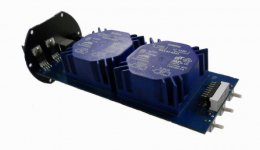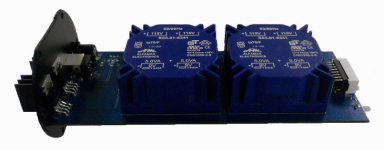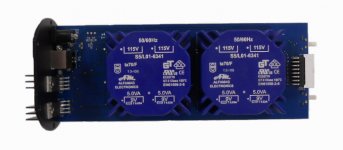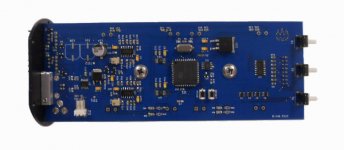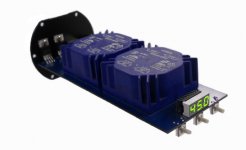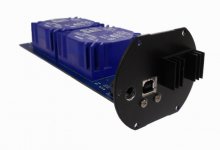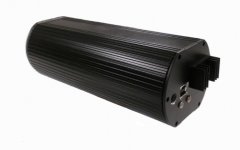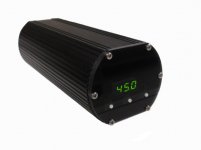Turntable speed control
Benb- I think you would be going in the wrong direction with your method. The two limiting factors in this detection scheme (and the one used by my device) are the ambiguity of the "event" detection itself and in your case, the accuracy of the positioning of the spots. In my case, I'm able to resolve the detection of a once per rev event with < 0.001" accuracy in order to give 3 decimal places of accuracy (37.7" circ/0.001" or 1 in ~37000) which would seem to be approaching the limit of mechanical detection means and visual verification. By multiplying the number of events by 432 you automatically increase the error factor by 432x since the event window is now 0.087" and the resolution will be .087/.001 or 1 in 87, ie < 1%. This is assuming the spots are perfectly placed at even intervals which is most likely not achievable either on printed media or via machining on the platter. One advantage of using only one event per rev, is it removes the problem of accurate placement: If securely fastened, it can only occur at exactly the same point each rev, the limiting factor now singularly being the ambiguity of the detection mechanism. I also needed a solution that would work on any table, not just the ones with machining on the edges, and something that would work during disc play.
There still seems to be some confusion about what function the tach provides. As many have commented, it cannot (and does not attempt to) provide wow and flutter information, something the software promoted by SQ225917 does a much better job at. However, my concern is belt drive TTs and the reduction of wow and flutter via SPEED control of the drive motor is problematic at best (vibration control being another matter altogether). I built the tach to accurately measure results when testing a new PSU design I've been working with. One thing I discovered was no matter how accurate and stable the PSU, a belt drive table will drift off speed over time, for any number of reasons as previously posted. The logical conclusion I came to was to use the tach to correct this long term drift while allowing the PSU to do its job on short term stability and the platter to do its best on per rev stability. I was hoping to get useful feedback and critique of my design that might help improve on what I am trying to accomplish, but with the exception of a very few, I've encountered nothing close to what I had hoped would be the spirit of DIY audio enthusiasts. Sour grapes makes for lousy wine I suppose.....
I've thought a bit about turntable speed sensing (other than the methods discussed so far).
To get better "high-frequency" resolution (better than 0.555...Hz at 33 1/3 RPM), there must be measurements many more times than once per revolution. Many platters offer this naturally with the strobe patterns on the side (or underneath, as in the Dual 1229). I calculate the 33 1/3, 60Hz band as having the highest resolution with 216 dots or squares (120Hz for neon light output divided by 0.555...Hz), or 432 transitions per revolution. I'm thinking this should provide adequate resolution (even a lightweight platter should provide a reasonably steady speed for 1/432 of a revolution from its flywheel effect). These transitions can be picked up with light using the light focused from an LED or even a small solid-state laser (think hand-held laser pointer), and the light picked up with a phototransistor or (for better timing and more accurate transitions) a photodiode.
Even if the spacings of these marks are not perfect, or the transitions are not exactly 50 percent duty cycle, these can be measured with a microcontroller to accuracy of a microsecond (or substantially less, depending on hardware timers available). If you put such a platter on a large, heavily weighted platter with a low-friction bearing that when spun does not slow down much (I recall a DIYaudio post with links to a two-part Youtube video of a platter spun fast that took around 15 minutes to slow to a stop), you can measure the exact time of each transition and store it for all 432 transitions (one might want to add an extra "index" transition to make it easy for the software to find the start). This (the 432 transition times) can be stored in the microcontroller's non-volatile (FLASH) memory, and compared to the transitions generated by an operating turntable, giving an accurate speed compared to a reference at the rate of 432 times per second. With careful math, one could measure the transitions of several revolutions and compensate for the decaying speed.
Another idea, using a platter with a flat cylindrical rim, put a circumference of magnetic tape on the outside of the rim, and have a tape head placed close enough to the rim to pick up a tone recorded on the tape. A higher frequency tone would require the tape head be closer to pick it up. The tape would have the wow and flutter of the recorder used to record the tone on the tape, but this could be compensated for by reading the timings of the tone's zero crossings while "calibrating" the platter on a heavy turning platter as above.
Benb- I think you would be going in the wrong direction with your method. The two limiting factors in this detection scheme (and the one used by my device) are the ambiguity of the "event" detection itself and in your case, the accuracy of the positioning of the spots. In my case, I'm able to resolve the detection of a once per rev event with < 0.001" accuracy in order to give 3 decimal places of accuracy (37.7" circ/0.001" or 1 in ~37000) which would seem to be approaching the limit of mechanical detection means and visual verification. By multiplying the number of events by 432 you automatically increase the error factor by 432x since the event window is now 0.087" and the resolution will be .087/.001 or 1 in 87, ie < 1%. This is assuming the spots are perfectly placed at even intervals which is most likely not achievable either on printed media or via machining on the platter. One advantage of using only one event per rev, is it removes the problem of accurate placement: If securely fastened, it can only occur at exactly the same point each rev, the limiting factor now singularly being the ambiguity of the detection mechanism. I also needed a solution that would work on any table, not just the ones with machining on the edges, and something that would work during disc play.
There still seems to be some confusion about what function the tach provides. As many have commented, it cannot (and does not attempt to) provide wow and flutter information, something the software promoted by SQ225917 does a much better job at. However, my concern is belt drive TTs and the reduction of wow and flutter via SPEED control of the drive motor is problematic at best (vibration control being another matter altogether). I built the tach to accurately measure results when testing a new PSU design I've been working with. One thing I discovered was no matter how accurate and stable the PSU, a belt drive table will drift off speed over time, for any number of reasons as previously posted. The logical conclusion I came to was to use the tach to correct this long term drift while allowing the PSU to do its job on short term stability and the platter to do its best on per rev stability. I was hoping to get useful feedback and critique of my design that might help improve on what I am trying to accomplish, but with the exception of a very few, I've encountered nothing close to what I had hoped would be the spirit of DIY audio enthusiasts. Sour grapes makes for lousy wine I suppose.....
Last edited:
VPI turntable motors
If the 240V/50Hz motors rotate at 250 RPM (or 500 RPM?) then the pulley ratio would also have to be altered to give 33.33 and 45 RPM as well, correct? Using only the large pulley on the motor spindle, the ratio of line freq to platter RPM is then 1.333333:1 no matter what the configuration?
I think you meant to write 300 rpm and 250 rpm.
Sincerely,
Ralf
If the 240V/50Hz motors rotate at 250 RPM (or 500 RPM?) then the pulley ratio would also have to be altered to give 33.33 and 45 RPM as well, correct? Using only the large pulley on the motor spindle, the ratio of line freq to platter RPM is then 1.333333:1 no matter what the configuration?
If the 240V/50Hz motors rotate at 250 RPM (or 500 RPM?) then the pulley ratio would also have to be altered to give 33.33 and 45 RPM as well, correct? Using only the large pulley on the motor spindle, the ratio of line freq to platter RPM is then 1.333333:1 no matter what the configuration?
For an AC synchronous motor, speed in rpm is always 60 times line frequency in Hertz divided by the number of pole pairs. VPI have used 12 pole and 24 pole motors.
Pyramid. I don't think there's sour grapes on anyone's part, we all just have different experience and different ideas on what will work to make a stable TT. It's natural that the concepts we are invested in hold importance for us and that all posters, yourself included don't like to see those views being belittled. That's just human nature. There are very few people out there who are willing to look at every problem with an open eye and manage not to let their view of what might be possible, and beneficial, be framed by their own preconceptions and assumptions of what 'might' work.
The thing to do is to build your system, measure it by all means possible and then present the results to confound your critics and move the knowledge base onwards for those parties who are interested enough and open minded enough not to worry about having their views tested.
I'm very happy with my set-up with high viscous drag fronted by a large transformer and a simple phase shift capacitor who's value has been selected for least vibration on my specific motor, rather than just running a nominal value. It works for me. But I can't help wondering if it could be improved, so I've just finished building Meldano's TT-PSU and I'll investigate how will this works with it's voltage, frequency and phase shift being adjustable in the digital domain. if I can get it to work as well as my current solution then i'll start looking at how it can be improved by feeding in a signal other than a perfect sine wave.
Don't worry about the lack of positive response, this is one area of audio design where there really are very few people doing any serious investigation beyond rehashing old solutions in less expensive packages.
The thing to do is to build your system, measure it by all means possible and then present the results to confound your critics and move the knowledge base onwards for those parties who are interested enough and open minded enough not to worry about having their views tested.
I'm very happy with my set-up with high viscous drag fronted by a large transformer and a simple phase shift capacitor who's value has been selected for least vibration on my specific motor, rather than just running a nominal value. It works for me. But I can't help wondering if it could be improved, so I've just finished building Meldano's TT-PSU and I'll investigate how will this works with it's voltage, frequency and phase shift being adjustable in the digital domain. if I can get it to work as well as my current solution then i'll start looking at how it can be improved by feeding in a signal other than a perfect sine wave.
Don't worry about the lack of positive response, this is one area of audio design where there really are very few people doing any serious investigation beyond rehashing old solutions in less expensive packages.
Stick a fork in me, I'm done.
I appreciate your comments. I think to some extent, I have been attempting to do just what you recommeded. The problem is, I really don't need the frustration. I retired from successfully running my business for 20+ years and I think my time would be better spent on the golf course or with my family. I think I'd be happier just designing and building my projects for myself and keeping my mouth shut. I guess that makes this my final post.
I had a look at the Meldano design, looks very well built. I don't read German, but I think I got the gist of it. I hadn't thought of making the AC level adjustable from the front panel, but it wouldn't take much to add digital pots to both outputs (currently have 10T pots). Everything else looks similar in capabilities to my design: Dual DDS chips, 0.01 RPM adjustable freq, 1° adjustable phase, etc. I found an off the shelf extrusion to house it, 2.5"H x 3"W x 7" long.
Good luck with your project.
The thing to do is to build your system, measure it by all means possible and then present the results to confound your critics and move the knowledge base onwards for those parties who are interested enough and open minded enough not to worry about having their views tested.
I appreciate your comments. I think to some extent, I have been attempting to do just what you recommeded. The problem is, I really don't need the frustration. I retired from successfully running my business for 20+ years and I think my time would be better spent on the golf course or with my family. I think I'd be happier just designing and building my projects for myself and keeping my mouth shut. I guess that makes this my final post.
I had a look at the Meldano design, looks very well built. I don't read German, but I think I got the gist of it. I hadn't thought of making the AC level adjustable from the front panel, but it wouldn't take much to add digital pots to both outputs (currently have 10T pots). Everything else looks similar in capabilities to my design: Dual DDS chips, 0.01 RPM adjustable freq, 1° adjustable phase, etc. I found an off the shelf extrusion to house it, 2.5"H x 3"W x 7" long.
Good luck with your project.
Attachments
I own and did not build my TT:
Empire 509 motor/bearing/platter
German PS cap, looks like Empire OEM
Dynamat under the platter
1.5" thick alloy custom plinth
Maple cabinet and MDF platform plastered with Dynamat
Total mid 70 lb range w/Origin arm
A professional TT designer/builder recommended "analogue speed control" for the Empire 509. What is it and what purpose would it serve?
Tx!
Empire 509 motor/bearing/platter
German PS cap, looks like Empire OEM
Dynamat under the platter
1.5" thick alloy custom plinth
Maple cabinet and MDF platform plastered with Dynamat
Total mid 70 lb range w/Origin arm
A professional TT designer/builder recommended "analogue speed control" for the Empire 509. What is it and what purpose would it serve?
Tx!
I own and did not build my TT:
Empire 509 motor/bearing/platter
German PS cap, looks like Empire OEM
Dynamat under the platter
1.5" thick alloy custom plinth
Maple cabinet and MDF platform plastered with Dynamat
Total mid 70 lb range w/Origin arm
A professional TT designer/builder recommended "analogue speed control" for the Empire 509. What is it and what purpose would it serve?
Tx!
Moderator is welcome to delete this post. The guy who suggested "analogue speed control" wrongly thought my Empire was DD.
Hi,
well most any speed control for Turntables is working ´analogue´
I´ve heard that term beeing used with the speed cotrol used in the Brinkmann TTs.
They used this term to discriminate their speed control servo against a PLL servo.
Their servo works in that the sensor and associated electronics generate a speed proportional voltage (here, a frequency generator followed by a F-to-V converter).
This voltage is then compared to a reference voltage by a difference amplifier.
Due to the heavy filtering required to smoothen the rippled sensor voltage the system reacts ´slow´, hence its commonly used with platters with higher inertia (resp. lower driving-Force/inertia ratio).
A PLL-servo reacts on the frequency of the sensor signal, which allows to add a phase sensitive servo (the PLL) to the voltage sensitive servo.
It uses sample-and-hold circuits that react faster and require less post filtering than a F/V.
I assume that the term sample-and-hold that is far more related to the digital world made them use the term ´analogue´ for their servo.
But that is pure marketing, as a PLL as we know from our DDs, is purely analogue.
Talking of DDs vs. BDs, one could of course implement the same servos used for Direct Drives in a Belt Drive.
The point is though, that the motor of BD ´sees´ a much higher load inertia and its own reaction time (speeding up/slowing down) is much longer.
As the mechanical time constants in all TTs are much higher than the electronic time constants, a PLL servo simply wouldn´t improve anything.
To cope with short term speed instabilities both, DDs and BDs, mostly rely on inertia and mechanical precision of the parts.
As BDs typically feature higher mass/higher Inertia platters and the motor ´sees´ an increased inertia due the speed transmission from pulley to platter, a long time speed control is all what´s needed.
I guess thats where the ´confusion´ comes from Pyramid mentioned.
A ´faster´ speed control wouldn´t change anything noteable on the wowandflutter figures.
And for long time speed stability just one reference point per one revolution is more than sufficient.
jauuu
Calvin
well most any speed control for Turntables is working ´analogue´
I´ve heard that term beeing used with the speed cotrol used in the Brinkmann TTs.
They used this term to discriminate their speed control servo against a PLL servo.
Their servo works in that the sensor and associated electronics generate a speed proportional voltage (here, a frequency generator followed by a F-to-V converter).
This voltage is then compared to a reference voltage by a difference amplifier.
Due to the heavy filtering required to smoothen the rippled sensor voltage the system reacts ´slow´, hence its commonly used with platters with higher inertia (resp. lower driving-Force/inertia ratio).
A PLL-servo reacts on the frequency of the sensor signal, which allows to add a phase sensitive servo (the PLL) to the voltage sensitive servo.
It uses sample-and-hold circuits that react faster and require less post filtering than a F/V.
I assume that the term sample-and-hold that is far more related to the digital world made them use the term ´analogue´ for their servo.
But that is pure marketing, as a PLL as we know from our DDs, is purely analogue.
Talking of DDs vs. BDs, one could of course implement the same servos used for Direct Drives in a Belt Drive.
The point is though, that the motor of BD ´sees´ a much higher load inertia and its own reaction time (speeding up/slowing down) is much longer.
As the mechanical time constants in all TTs are much higher than the electronic time constants, a PLL servo simply wouldn´t improve anything.
To cope with short term speed instabilities both, DDs and BDs, mostly rely on inertia and mechanical precision of the parts.
As BDs typically feature higher mass/higher Inertia platters and the motor ´sees´ an increased inertia due the speed transmission from pulley to platter, a long time speed control is all what´s needed.
I guess thats where the ´confusion´ comes from Pyramid mentioned.
A ´faster´ speed control wouldn´t change anything noteable on the wowandflutter figures.
And for long time speed stability just one reference point per one revolution is more than sufficient.
jauuu
Calvin
Sorry for bumping this old thread. I have a question regarding the cleaning of turntables. I've heard you can damage your records if you get dirt on your stylus/cartridge, so thought I'd try cleaning mine. Does anyone have a few tips for this process? I've read a few guides but haven't found any conclusive answers. 
Update: Found the answer myself. I got myself a Mr. Clean magic eraser sponge and it works like a charm. It's a pretty cheap solution as well.Sorry for bumping this old thread. I have a question regarding the cleaning of turntables. I've heard you can damage your records if you get dirt on your stylus/cartridge, so thought I'd try cleaning mine. Does anyone have a few tips for this process? I've read a few guides but haven't found any conclusive answers.
Tip found here: How to Clean A Turntable Needle (The RIGHT Way) - Stylus Cleaning
Hi all,
a couple of questions im sure you have all discussed at some point regarding motor choices:
has anyone used or tried a brushless RC plane/drone motor? something like this A 2212 A2212 2200KV Brushless Outrunner Motor Mount 6T For RC Aircraft Plane Multi copter Quadcopter Drone F02048-in Parts & Accessories from Toys & Hobbies on Aliexpress.com | Alibaba Group
and it be driven by something like this DC 5V 12V 2A 15W Brushless Motor Speed Controller No Hall BLDC Driver Board-in Motor Controller from Home Improvement on Aliexpress.com | Alibaba Group
or the other motor idea being a hard drive motor (3 phase, 4 wire) and driven by something like this 1Pc 5V 12V DC Brushless Driver Board Controller For Hard Drive Motor 3/4 Wire-in Motor Controller from Home Improvement on Aliexpress.com | Alibaba Group
thoughts?
a couple of questions im sure you have all discussed at some point regarding motor choices:
has anyone used or tried a brushless RC plane/drone motor? something like this A 2212 A2212 2200KV Brushless Outrunner Motor Mount 6T For RC Aircraft Plane Multi copter Quadcopter Drone F02048-in Parts & Accessories from Toys & Hobbies on Aliexpress.com | Alibaba Group
and it be driven by something like this DC 5V 12V 2A 15W Brushless Motor Speed Controller No Hall BLDC Driver Board-in Motor Controller from Home Improvement on Aliexpress.com | Alibaba Group
or the other motor idea being a hard drive motor (3 phase, 4 wire) and driven by something like this 1Pc 5V 12V DC Brushless Driver Board Controller For Hard Drive Motor 3/4 Wire-in Motor Controller from Home Improvement on Aliexpress.com | Alibaba Group
thoughts?
after leaving the LYD42 Hurst motor running for a week and applying a little 3-in-1 oil (light machine oil) to the bearings as per George Merrill, I can safely say the motor is very quiet .The motor I chose is substantially more robust than those intended for turntable use.
I am mounting it in an Ariston 11s , at the (approximately) 7:30 position as per the Funk Firm and others. I have to say I am completely disappointed with the build quality of the Ariston. Linns are essentially the same thing, and I'd be even more disappointed had I paid for a new LP12...
I have acquired a Hurst LYD42115D motor for my DIY project. I have run it on the bench, no load, for a month and it is quite reliable at 300 rpm/115v/60hz and almost noiseless. However, it gets very hot. Not so ho that you can't hold it but, very uncomfortable hot. I am accustomed to DC motors that get warm.
Is this normal for synchronous AC motors of this type in your experience?
If you can hold it its not normally a problem. Commercially many electric motors run at 80C or higher, although that's too much for a turntable motor obviously. Usually commercial motors assume the mounting flange has a significant heat-sinking role, but for turntable use you'd use rubber bushings obviously. The sleeve bearings will need oiling every year or so, perhaps more would be wise if its hot.
If you can hold it its not normally a problem. Commercially many electric motors run at 80C or higher, although that's too much for a turntable motor obviously. Usually commercial motors assume the mounting flange has a significant heat-sinking role, but for turntable use you'd use rubber bushings obviously. The sleeve bearings will need oiling every year or so, perhaps more would be wise if its hot.
Thanks much for the info. I'll mount it and see what happens.
Overview of single DC Motors and Motor Units incl. Control Unit and Envelope for Outdoor use
1) Single Motors
Maxon 110189 DC
https://www.maxongroup.com/maxon/view/product/motor/dcmotor/amax/amax26/110189
https://www.theanalogdept.com/maxon.htm
https://teresaudio.com/project/index.html#motor
Maxon 226774 DC
https://www.maxongroup.de/maxon/view/product/motor/dcmotor/remax/remax29/226774
https://electravolt.blogspot.com/2022/06/move-groove.html
Portescap 26N58-216E.1/28L28-416E.49
https://www.portescap.com/en/products/brush-dc-motors/26n58-brush-dc-coreless-motor
https://de.rs-online.com/web/p/gleichstrommotoren/2532515
https://docs.rs-online.com/c38a/0900766b8002e891.pdf
https://de.rs-online.com/web/p/gleichstrommotoren/1925988
https://docs.rs-online.com/65a0/0900766b80fd0ddb.pdf
VPI 300RpM Scoutmaster
https://www.musicdirect.com/equipme...motor-upgrade-for-vpi-scoutmaster-12-platter/
2) Motor+Control Unit
https://www.zikodrive.com/shop/brus...ontroller-package-for-turntable-applications/
http://www.true-point.audio/tpa_audio_dc_Motor_Kit.htm
3) Outdoor Motor Units
Scheu DC Motor
https://highend-sound.com/produkter/vinyl-tilbehoer-1000vis/dc-motor-kits/scheu-dc-motor/
https://highend-sound.com/produkter/byg-selv-din-pladespiller/dc-motorstyring/scheu-dc-motor/
http://www.scheu-analog.de/zubehoer/
http://www.scheu-analog.de/laufwerke/premier/
Jasmine-TM-R501
https://www.newbecca.com/product/533278312530
https://de.aliexpress.com/item/32828246982.html
http://www.troelsgravesen.dk/maglev/jasmine.pdf
https://www.monoandstereo.com/2018/11/jasmine-tm-r50-turntable-motor.html
https://www.audio-markt.de/market/jasmine-jasmine-tm-r501-mkii-turntable-motor-785444048
https://www.canuckaudiomart.com/det...turntable-motor-diy-turntable/images/3205838/
https://arsantiquaudio.com/producto/jasmine-tm-r501-turntable-motor-tocadiscos/
https://www.diyaudio.com/community/threads/jasmine-audio-turntable-motor.373579/#post-6817076
VPI MOTOR AND HOUSING
https://www.analogueseduction.net/vpi-upgrades-parts-accessories/vpi-prime-motor-and-housing.html
https://www.analogueseduction.net/vpi-upgrades-parts-accessories/vpi-scout-21-motor-and-housing.html
Verus II Direct Coupled Motor
http://www.teresaudio.com/verus-motor.html
Dr. Feickert Motor
https://audionote.wordpress.com/2010/11/01/dr-feickert’s-twin-turntable/#jp-carousel-393
https://6moons.com/audioreviews/feickert2/twin.html
https://6moons.com/audioreviews/feickert/feickert.html
https://www.analog-forum.de/wbboard/index.php?thread/59587-dr-feickert-motor/
Motordose DAE-1
https://shop.hsga-gmbh.de/dereneville-antriebseinheit-dereneville-dae-01-cl-120556
https://www.dereneville.de/Story_Ref_DAE.html
https://www.analog-forum.de/wbboard...solid-wood-plus-motordose-dae-1-vom-derainer/
SOTA Eclipse Series
https://sotaturntables.com/product-category/eclipse-series/
DC Motor 67016202007
http://shop.diyhifisupply.com/produ...dc-motor-controller-for-belt-drive-turntable/
Diy Versions
https://www.audioasylum.com/message...quot-stand-alone-motor-diy-sama-for-vpi-hw-19
https://www.audioasylum.com/cgi/vt.mpl?f=vinyl&m=1187047
https://www.diyaudio.com/community/threads/3-phase-class-d-amp-for-diy-bldc-motor-drive.307918/
Which of this mentioned motors resp. motor units should I prefer ?
Where are threads concerning the most interesting diy projects with the above mentioned single DC motors ?
Best thanks for advices.
P.S.: Have synchronous motors like those under
https://attitube.com/diy-record-player/diy-record-player/
http://www.altmann.haan.de/turntable/
https://webcache.googleusercontent....ntable/&cd=1&hl=de&ct=clnk&gl=de&client=opera
https://www.hurst-motors.com/lyd42directdrive.html
the same quality level concerning speed deviations ?
check out also the threads concerning suppliers overview:
https://www.diyaudio.com/community/...art-suppliers-bearing-spindle-platter.390368/
https://www.diyaudio.com/community/threads/diy-turntable-build-with-motor-and-controller.380345/
1) Single Motors
Maxon 110189 DC
https://www.maxongroup.com/maxon/view/product/motor/dcmotor/amax/amax26/110189
https://www.theanalogdept.com/maxon.htm
https://teresaudio.com/project/index.html#motor
Maxon 226774 DC
https://www.maxongroup.de/maxon/view/product/motor/dcmotor/remax/remax29/226774
https://electravolt.blogspot.com/2022/06/move-groove.html
Portescap 26N58-216E.1/28L28-416E.49
https://www.portescap.com/en/products/brush-dc-motors/26n58-brush-dc-coreless-motor
https://de.rs-online.com/web/p/gleichstrommotoren/2532515
https://docs.rs-online.com/c38a/0900766b8002e891.pdf
https://de.rs-online.com/web/p/gleichstrommotoren/1925988
https://docs.rs-online.com/65a0/0900766b80fd0ddb.pdf
VPI 300RpM Scoutmaster
https://www.musicdirect.com/equipme...motor-upgrade-for-vpi-scoutmaster-12-platter/
2) Motor+Control Unit
https://www.zikodrive.com/shop/brus...ontroller-package-for-turntable-applications/
http://www.true-point.audio/tpa_audio_dc_Motor_Kit.htm
3) Outdoor Motor Units
Scheu DC Motor
https://highend-sound.com/produkter/vinyl-tilbehoer-1000vis/dc-motor-kits/scheu-dc-motor/
https://highend-sound.com/produkter/byg-selv-din-pladespiller/dc-motorstyring/scheu-dc-motor/
http://www.scheu-analog.de/zubehoer/
http://www.scheu-analog.de/laufwerke/premier/
Jasmine-TM-R501
https://www.newbecca.com/product/533278312530
https://de.aliexpress.com/item/32828246982.html
http://www.troelsgravesen.dk/maglev/jasmine.pdf
https://www.monoandstereo.com/2018/11/jasmine-tm-r50-turntable-motor.html
https://www.audio-markt.de/market/jasmine-jasmine-tm-r501-mkii-turntable-motor-785444048
https://www.canuckaudiomart.com/det...turntable-motor-diy-turntable/images/3205838/
https://arsantiquaudio.com/producto/jasmine-tm-r501-turntable-motor-tocadiscos/
https://www.diyaudio.com/community/threads/jasmine-audio-turntable-motor.373579/#post-6817076
VPI MOTOR AND HOUSING
https://www.analogueseduction.net/vpi-upgrades-parts-accessories/vpi-prime-motor-and-housing.html
https://www.analogueseduction.net/vpi-upgrades-parts-accessories/vpi-scout-21-motor-and-housing.html
Verus II Direct Coupled Motor
http://www.teresaudio.com/verus-motor.html
Dr. Feickert Motor
https://audionote.wordpress.com/2010/11/01/dr-feickert’s-twin-turntable/#jp-carousel-393
https://6moons.com/audioreviews/feickert2/twin.html
https://6moons.com/audioreviews/feickert/feickert.html
https://www.analog-forum.de/wbboard/index.php?thread/59587-dr-feickert-motor/
Motordose DAE-1
https://shop.hsga-gmbh.de/dereneville-antriebseinheit-dereneville-dae-01-cl-120556
https://www.dereneville.de/Story_Ref_DAE.html
https://www.analog-forum.de/wbboard...solid-wood-plus-motordose-dae-1-vom-derainer/
SOTA Eclipse Series
https://sotaturntables.com/product-category/eclipse-series/
DC Motor 67016202007
http://shop.diyhifisupply.com/produ...dc-motor-controller-for-belt-drive-turntable/
Diy Versions
https://www.audioasylum.com/message...quot-stand-alone-motor-diy-sama-for-vpi-hw-19
https://www.audioasylum.com/cgi/vt.mpl?f=vinyl&m=1187047
https://www.diyaudio.com/community/threads/3-phase-class-d-amp-for-diy-bldc-motor-drive.307918/
Which of this mentioned motors resp. motor units should I prefer ?
Where are threads concerning the most interesting diy projects with the above mentioned single DC motors ?
Best thanks for advices.
P.S.: Have synchronous motors like those under
https://attitube.com/diy-record-player/diy-record-player/
http://www.altmann.haan.de/turntable/
https://webcache.googleusercontent....ntable/&cd=1&hl=de&ct=clnk&gl=de&client=opera
https://www.hurst-motors.com/lyd42directdrive.html
the same quality level concerning speed deviations ?
check out also the threads concerning suppliers overview:
https://www.diyaudio.com/community/...art-suppliers-bearing-spindle-platter.390368/
https://www.diyaudio.com/community/threads/diy-turntable-build-with-motor-and-controller.380345/
Last edited:
check out concerning DC motor control units post #31 under
https://www.diyaudio.com/community/threads/mark-kellys-dc-motor-articles.159156/page-2#post-7196515
https://www.diyaudio.com/community/threads/mark-kellys-dc-motor-articles.159156/page-2#post-7196515
- Home
- Source & Line
- Analogue Source
- The Official Turntable Drive System/Motor Thread!
